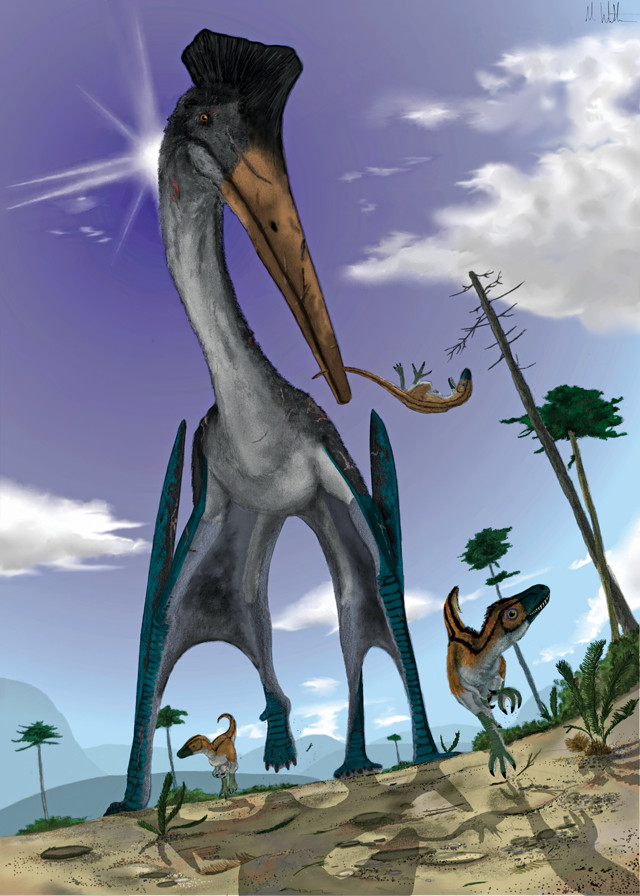
by Mary Caperton Morton Monday, February 2, 2015

Pterosaurs likely launched themselves into the air using both their forelimbs and hindlimbs. Credit: Mark Witton.
Pterosaurs are the largest flying animals in Earth’s history — some boasted nearly double the wingspan of the largest flying birds. But just how big the airborne reptiles grew and what kept them from achieving even greater sizes are outstanding questions. Now, a new study examining the mechanics of pterosaur flight suggests that taking off was perhaps the trickiest part of flying for pterosaurs, and likely constrained their size more so than other factors.
“There is no question that pterosaurs could fly. Everything about their fossil remains tells us they were flying animals,” says Colin Palmer, a mechanical engineer at the University of Bristol in England, who presented the new study at the Society of Vertebrate Paleontology meeting in Berlin in November, along with Mike Habib, a paleontologist at the University of Southern California.
Most pterosaur fossils suggest animals with wingspans measuring between 6 and 8 meters, but fragmentary remains hint at even larger specimens that were perhaps 10 to 12 meters from wingtip to wingtip. That dwarfs the largest known species of flying birds, which had wingspans of about 6 meters.
“The fact that pterosaurs were so much larger than birds suggests that there was something special about the way they flew that enabled them to get so big,” Palmer says.
Unlike birds, which launch themselves into the air using momentum generated by running along the ground with their legs, pterosaurs used both their arms and legs to leap forward in a maneuver dubbed the quadrupedal launch.
“When the quadrupedal launch was proposed [in 2008 by Habib], it solved all sorts of problems we had with pterosaur flight,” says Mark Witton, a paleontologist at the University of Portsmouth in England, who was not involved in the study — including how they got off the ground.
Birds’ anatomy and weight are largely concentrated in their legs, “which are usually the most robust bones in their bodies. But once they get into the air, their legs are dead weight,” Palmer says. “Pterosaurs had a much more efficient anatomy [for flying] because their forelimbs were used for both take off and flight. That’s one of their great secrets of success.”
But that success only carried pterosaurs so far size-wise, Palmer says. Flying requires three main actions: taking off, maintaining lift and landing. To test which of these may have capped the upper size limit of pterosaurs, Palmer and Habib used CT scans of pterosaur fossils to create computer models of specimens with wingspans between 6 and 12 meters.
Using software to estimate the wing strength, flexibility, flying speed and power required for flight in massive pterosaurs, they found that taking off proved trickiest for the largest animals. These hypothetical animals were grounded by the extreme forces needed to lift the mass of a pterosaur with an 11- to 12-meter wingspan off the ground. “This launch constraint suggests to us that the upper size limit for pterosaurs was about 10 meters,” Palmer says.
Once airborne, all of the pterosaurs modeled could maintain flight, but landing safely also became problematic for the largest animals. Pterosaurs with wingspans of more than 10 meters “would need perfect conditions for landing without breaking bones,” Palmer says. “Animals can’t live long if they can only function under perfect conditions.”
The findings line up with the maximum sizes found in the fossil record, Witton says. “Fossil data is fairly inconclusive for pterosaurs [with wingspans more than] 10 meters, so this study seems to be a pretty sensible estimate for the maximum pterosaur size.”
© 2008-2021. All rights reserved. Any copying, redistribution or retransmission of any of the contents of this service without the expressed written permission of the American Geosciences Institute is expressly prohibited. Click here for all copyright requests.